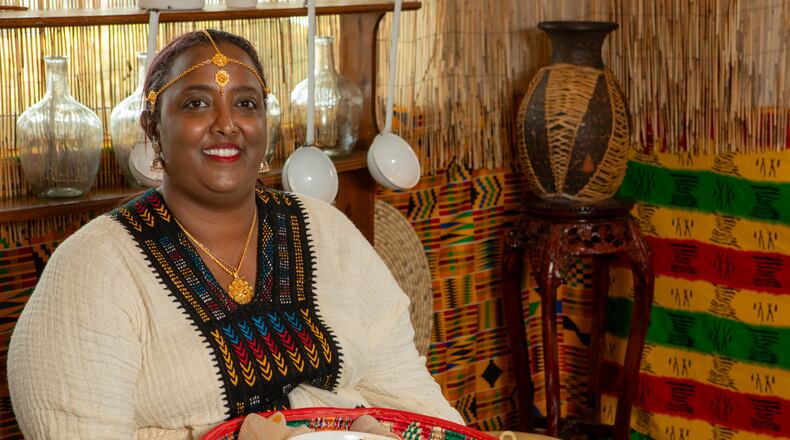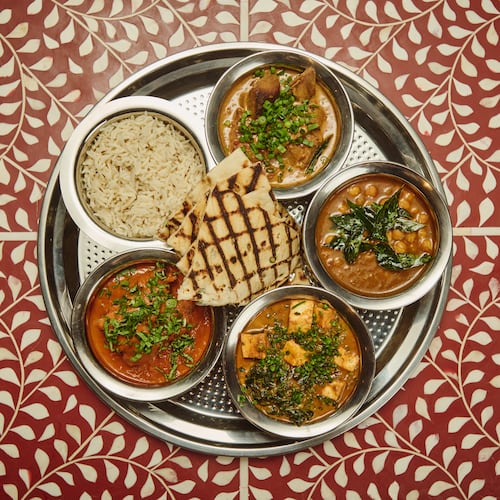There’s often a bowl of boiled eggs in my refrigerator. They’re perfectly packaged little containers of protein, easy to grab when I need a quick snack or lunch at my desk. When I entertain, I turn them into deviled eggs which almost no one turns down no matter which recipe I try. And I’ve tried dozens.
And when the lure of simple boiled or deviled eggs fades, there’s always egg salad, or chopping them into potato salad or serving them as part of a Cobb salad.
But in many cultures boiled eggs aren’t an afterthought, they’re the stars. For example, Burmese nan gyi thoke is a dish of highly seasoned rice noodles tossed with ground chicken, chile powder and fish sauce, topped with boiled eggs. Spicy Indian egg masala simmers hard-cooked eggs in a tangy tomato-based sauce. Egg keema is the vegetarian version of a South Asian dish with boiled eggs substituted for meat and cooked in spices and onions.
We turned to three Atlanta chefs to get their take on boiled eggs as the centerpiece for a meal. Kevin Gillespie of Nadair and Gunshow offered his updated version of his grandmother’s Scotch eggs. Jason Liang of Brush Sushi provided a simplified version of the restaurant’s duck shoyu ramen with a soy and rice wine-marinated egg. And Yohana Solomon of Chow a la Carte shared her recipe for doro wet, more commonly known as doro wat, a communal dish of chicken and boiled eggs in a spicy onion sauce.
In sharing their recipes, the three chefs also helped me overcome what I find is the hardest part of producing boiled eggs — getting a perfectly peeled final result. I’ve experimented with many methods. Is it best to start with super fresh eggs direct from the farmer? Slightly older eggs from the grocery store case? Cold eggs? Room-temperature eggs? Eggs started in cold water? Eggs started in hot water?
The good news is that following the directions of these chefs resulted in tender egg whites and yolks cooked to varying degrees, depending on the recipe. Every egg peeled perfectly.
And it didn’t matter if the eggs were days old or weeks old.
RECIPES
Three Atlanta chefs offer recipes for boiled egg main dishes that come from the United Kingdom, Japan and Ethiopia.
Kevin Gillespie’s Scotch Eggs
This recipe is adapted from chef Kevin Gillespie’s “Fire in My Belly: Real Cooking” (Andrews McMeel Publishing, 2012). Gillespie developed this recipe based on the Scotch eggs his grandmother served every Christmas morning, but solving the problems he recognized even as a child. Hard-boiled eggs wrapped in sausage and deep fried meant the eggs were overdone and the sausage lost its succulence in the fryer.
The recipe in the cookbook offers directions for making your own sausage and pickled horseradish to accompany the Scotch eggs. For our photo, Gillespie styled the egg with Spicy Horseradish Mustard.
Gillespie wrote, “One whole egg makes for a hearty first course, whereas a half egg is what we would serve in a multi-course meal or for a snack.”
4 room-temperature eggs
3 slices bacon
1/2 pound ground pork sausage
Canola oil, for frying
1 refrigerated egg
About 1/4 cup all-purpose flour
About 1/2 cup finely ground and sifted panko
Spicy Horseradish Mustard, for serving (optional) (see recipe)
Make soft-boiled eggs: Put 4 room-temperature eggs into a bowl of warm water deep enough to cover the eggs.
Bring 4 cups of water to boil in a medium saucepan. Have a large bowl of ice water next to the cooktop.
Using a slotted spoon, lower warm eggs into boiling water. Cook 6 minutes. Using a slotted spoon, transfer eggs from saucepan to the bowl of ice water. While eggs are in the ice water, use the back of a spoon to gently crack the shells. This will let some cold water into the shells, stop the cooking process and make the eggs easier to peel. Stir the eggs in the ice water until they are cool, about 2 minutes. Then carefully peel the eggs, pat dry and set aside. Reserve the bowl of ice water.
Use kitchen scissors to cut bacon into very thin strips, then use a chef’s knife to cut strips into very fine dice. Bacon should be same texture as the sausage.
In a medium bowl set into the reserved bowl of ice water, combine bacon and sausage. Mix thoroughly with your hands but make sure mixture does not get warm from the heat of your hands. Divide sausage into four equal portions and roll each into a ball. One at a time, flatten each ball into a disk 5 to 6 inches in diameter. Wrap disk completely around one of the soft-boiled eggs. Transfer wrapped egg to a plate and continue until all eggs are wrapped. Cover plate with plastic wrap and refrigerate 1 hour, up to overnight.
Cook Scotch eggs: heat 2 inches of oil in a Dutch oven over high heat to 350 degrees. Line a plate with a double layer of paper towels and set next to cooktop.
In a small bowl, whip refrigerated egg until fluffy. Put flour in a second bowl and panko in a third bowl.
Working with one egg at a time, dip cold eggs into whipped egg, making sure to coat entirely. Transfer egg to flour and make sure to coat entirely with flour. Dust off loose flour and transfer egg to panko, making sure to coat entirely with panko. Set coated egg back on plate and prepare remaining three eggs. When oil is ready, use a slotted spoon to transfer eggs to hot oil and fry for 4 minutes, then turn and fry an additional 4 minutes. Use slotted spoon to transfer cooked eggs to paper towel-lined plate to drain. Cut eggs in half and serve while warm with Spicy Horseradish Mustard, if desired.
Makes 4 eggs.
Per egg: 506 calories (percent of calories from fat, 70), 21 grams protein, 17 grams carbohydrates, 1 gram total sugars, 1 gram fiber, 39 grams total fat (21 grams saturated), 288 milligrams cholesterol, 805 milligrams sodium.
Spicy Horseradish Mustard
Mother’s Red Chilli Garlic Chutney is available online and Kewpie mayonnaise can be found in stores that carry Asian groceries.
1 tablespoon Colman’s dry mustard
1 tablespoon room temperature water
1/2 cup Kewpie mayonnaise
1 tablespoon prepared horseradish
1 tablespoon Dijon mustard
2 teaspoons Mother’s Red Chilli Garlic Chutney
In a small bowl, stir dry mustard and water. Let stand 10 minutes, then add mayonnaise, horseradish, Dijon mustard and chutney. Cover and refrigerate until ready to use.
Makes 3/4 cup.
Per tablespoon: 27 calories (percent of calories from fat, 70), trace protein, 2 grams carbohydrates, 1 gram total sugars, trace fiber, 2 grams total fat (trace saturated fat), 2 milligrams cholesterol, 110 milligrams sodium.
Credit: Courtesy of ChingYao Wang
Credit: Courtesy of ChingYao Wang
Easy Chicken Shoyu Ramen
Jason Liang of Brush Sushi offers this simplified version of the restaurant’s Truffle Duck Shoyu Ramen that combines duck breast and chicken with chives, bamboo shoots and ramen noodles and is topped with a ramen egg. Liang suggests any seasonal green would work in this recipe. “I personally like watercress, Chinese spinach, corn or baby corn,” he said.
Shoyu ramen is perhaps the most common type of ramen in Japan and ramen eggs, or ajitama, are soft-boiled eggs marinated in a sweetened mixture of soy sauce and rice wine. They’re a traditional topping for ramen, but are also delicious in rice bowls and salads. The ramen eggs must marinate overnight so start them a day ahead and while you are at it, make a few extra to enjoy in other dishes or to serve alone as a snack.
A push pin makes a good tool for pricking the raw eggs. Be sure to make the tiniest possible hole, otherwise egg white will leak out of the egg and boiling water will enter the egg, creating unsightly pockets in the cooked egg white.
3/4 cup plus 2 tablespoons water
7 tablespoons soy sauce, divided
3 tablespoons rice wine or sake
2 tablespoons light brown sugar
4 eggs
8 ounces fresh, frozen or dry ramen noodles
1/4 cup Scallion Ginger Oil (see recipe)
5 cups low-sodium chicken broth
1/4 pound chicken breast, cut into 12 thin slices
2 teaspoons extra-virgin olive oil
Salt
Pepper
8 sprigs watercress or steamed broccolini
Thinly sliced dark green portion of scallions, for garnish
Make ramen egg: In a small saucepan, make marinade by stirring together water, 3 tablespoons soy sauce, rice wine or sake and brown sugar. Bring to a boil over high heat and stir until sugar dissolves, about 1 minute. Remove from heat, move marinade to a bowl large enough to hold marinade plus 4 eggs and set aside to cool.
Bring a medium pot of water to a boil. Have a large bowl of ice water next to the cooktop. Using a push pin, poke a tiny hole in the rounded end of each egg and use a slotted spoon to carefully lower egg into boiling water. Continue with all eggs. Set a timer for 7 minutes. After 7 minutes, transfer eggs to ice bath and allow to cool. Once cooled, peel the eggs, then transfer eggs to marinade, cover and refrigerate overnight.
To serve: Prepare ramen noodles according to package directions.
In a small bowl, stir together Scallion Ginger Oil and remaining 4 tablespoons soy sauce. Set aside.
In a large saucepan, bring chicken broth to a boil. Brush sliced chicken on all sides with olive oil, then sprinkle with salt and pepper. Add to chicken broth, reduce heat so broth is simmering and cook chicken 2 minutes or until it is cooked through. Remove broth from heat and add Scallion Ginger Oil mixture.
Divide broth, chicken and cooked ramen between 4 rimmed bowls. Divide watercress or broccolini between bowls. Cut ramen eggs in half and add one egg to each bowl and garnish with sliced scallions. Discard marinade. Serve immediately.
Serves 4.
Per serving: 795 calories (percent of calories from fat, 58), 35 grams protein, 48 grams carbohydrates, 6 grams total sugars, 1 gram fiber, 51 grams total fat (12 grams saturated), 227 milligrams cholesterol, 2,930 milligrams sodium.
Scallion Ginger Oil
The oil not needed for the Easy Chicken Shoyu Ramen can be stored, covered, for up to two weeks and drizzled over roasted vegetables or noodles.
1/4 cup chopped scallions
1/4 cup peeled grated ginger
1/2 cup vegetable oil
In the bowl of a food processor fitted with the metal blade, combine scallions and ginger and pulse until finely chopped.
In a small saucepan, bring oil to a boil, then add the scallion-ginger mixture and cook over high heat until the scallions and ginger turn golden brown, about 3 minutes. Remove from heat, allow to cool, then strain oil and transfer to a jar. Discard scallions and ginger. Cover and refrigerate oil until needed.
Makes 1/4 cup plus 3 tablespoons.
Per tablespoon: 140 calories (percent of calories from fat, 98), trace protein, 1 gram carbohydrates, trace total sugars, no fiber, 15 grams total fat (2 grams saturated), no cholesterol, 1 milligram sodium.
Doro Wet (Ethiopian Chicken Stew)
Chef Yohana Solomon is co-founder of Chow Club Atlanta and Chow a la Carte. Solomon was born and raised in Ethiopia to parents originally from Eritrea. She immigrated to the U.S. in 1998 when the Eritrean–Ethiopian War started.
When sharing the recipe, she wrote, “Preparing this traditional dish is how a young woman in Ethiopia is tested to see if she is ready for marriage.” Her mother, Gezachin Fantaye, made sure she and her two sisters knew how to make it properly and Solomon says the addition of boiled eggs to Doro Wet is traditional as a way to honor the chickens used in the dish.
Berbere and niter kibbeh (Ethiopian spiced clarified butter) can be purchased by ordering from chowalacarteatl@gmail.com or at local Ethiopian stores such as Yeshi Food Mart in Clarkston where you will also find injera, the fermented flatbread torn into pieces and used as a utensil for eating this dish.
4 cold eggs
2 1/2 pounds red onions, roughly chopped
1/2 cup Morton kosher salt
Juice of 2 limes
4 skinless chicken drumsticks or thighs
2 1/2 cups water, divided, plus more for brining and rinsing chicken
1 cup niter kibbeh (see note)
3 tablespoons berbere
1 2-inch ginger piece, peeled
6 cloves garlic
1 tablespoon table salt, plus more to taste
Injera, for serving
Cook eggs: Bring a medium pot of water to boil over high heat. Have a large bowl of ice water next to the cooktop. Use a slotted spoon to carefully lower eggs into boiling water and cook for 10 minutes. Transfer eggs to ice water and set aside to cool. Once cooled, peel the eggs and set aside.
Prepare Doro Wet: In the bowl of a food processor fitted with the metal blade, pulse onion until it is finely minced. Transfer onion to a dry Dutch oven over medium heat and cook, stirring frequently, until onions release their liquid and the onions become tender, about 15 minutes. Do not rinse food processor bowl.
As the onions start cooking, combine kosher salt and lime juice in a large bowl. Add chicken drumsticks or thighs and water to cover. Let chicken sit 10 minutes, then pour off salted water. Keep chicken in bowl and add cool water to cover. Drain and repeat twice or until the rinse water is clear. Return chicken to bowl and set aside.
Add niter kibbeh to the onions and cook 5 minutes. Stir berbere into 1/2 cup water until dissolved, add to the onions and cook 4 minutes. Transfer chicken to Dutch oven and stir in 1 cup water.
In the bowl of the food processor, process ginger and garlic until pureed. Stir puree into chicken mixture. Reduce heat so the mixture is simmering, add remaining 1 cup water and table salt. Let chicken cook uncovered 30 minutes or until it is cooked through and tender.
While chicken is cooking, use a knife to score surface of cooled eggs into quarters. This helps the egg absorb some of the sauce. When chicken is tender, stir eggs into sauce and taste sauce for seasoning, adding salt if needed. When eggs have warmed through, about 4 minutes, transfer everything to a serving bowl and serve with injera to be used as a utensil.
Serves 4.
Per serving: 811 calories (percent of calories from fat, 63), 39 grams protein, 37 grams carbohydrates, 22 grams total sugars, 6 grams fiber, 58 grams total fat (32 grams saturated), 441 milligrams cholesterol, 2,561 milligrams sodium.
Sign up for the AJC Food and Dining Newsletter
Read more stories like this by liking Atlanta Restaurant Scene on Facebook, following @ATLDiningNews on X and @ajcdining on Instagram.
About the Author
Keep Reading
The Latest
Featured





